A Comprehensive Study into the Boltless Connections of Racking Systems
Abstract
1. Introduction
2. Configuration of a Pallet Racking
- simple or elastic joints,
- semi-rigid joints and.
- continuous or rigid joints.
3. Analytical Approach and Experimental Study on Beam-to-Column Connections
- bending strength, Mj,Rd,
- rotational stiffness, Sj, and
- rotational capacity, ΦCd.
3.1. Cantilever Test
- the column profile,
- the thickness of the column wall,
- the beam profile,
- the thickness of the beam walls,
- the position of the connector on the beam,
- the way of connection between the connector and the beam,
- the connector type and
- the characteristics of the materials for all elements in the connection.
3.1.1. Experiment Set-up
- two gauges C1 and C2 as shown in Figure 3 bearing onto a plate fixed to the beam near to the connector, but far from it in order to allow for connector distortion, or
- by an inclinometer connected to the beam close to the connector.
3.1.2. Experiment Procedure
- a—the length at which the force F acts,
- D—distance between the displacement transducers on the opposite sides of the beam,
- δ1, δ2—displacement measured by gauges C1 and C2.
- δ3 is the displacement measured by gauge C3,
3.1.3. Test Results
3.2. Frye-Morris Polynomial Model
- Φr—relative rotation in rad,
- M—moment of rotation in Nmm,
- K—coefficient that scales the ordinate of curves,
- C1, C2C3—constants for curve fitting.
- qj—numerical value of j parameter,
- aj—exponent that shows the effect of the numerical value of the j parameter on the moment-rotation relation,
- m—number of parameters j.
4. Numerical Analysis of Beam-to-Column Connection
4.1. Finite Element Model of Cantilever Test
- Column with 41,356 3D 8-nodal finite elements, Figure 7a.
- Beam with 150,540 3D 8-nodal finite elements, Figure 7b.
- Beam-end connector with 63,777 3D 8-nodal finite elements, Figure 7c.
- Screws for joint beam-end connector and beam with 3395 3D 8-nodal finite elements, Figure 7d.
- Load transfer plate with 4136 shell elements, Figure 7e.
- 1D finite elements, i.e., rods were used for load modeling, Figure 7f.
- Surface-to-surface contact elements were used for the connected parts in samples: the column-beam end connector, beam end connector-beam and beam parts for blocking the lateral movement.
4.2. Influence of the Column and Beam Wall Thickness on the Behaviour of the Connection
4.3. Influence of the Height of the Beam Profile and Beam-End Connector on the Behaviour of the Connection
5. Conclusions
Author Contributions
Funding
Conflicts of Interest
References
- Eurocode 3: EN 1993-1-1: 2005, Design of Steel Structures, Part 1-1: General Rules and Rules for Buildings, Part 1-3: General Rules—Supplementary Rules for Cold Formed Thin Gauge Members and Sheeting, Part 1-8: Design of Joints; European Union: Brussels, Belgium, 2005.
- Lewis, G.M. Stability of rack structures. Thin Walled Struct. 1991, 12, 163–174. [Google Scholar] [CrossRef]
- Markazi, F.D.; Beale, R.G.; Godley, M.H.R. Experimental Analysis of Semi-Rigid Boltless Connectors. Thin Walled Struct. 1997, 28, 57–87. [Google Scholar] [CrossRef]
- Godley, M.H.R. Plastic design of pallet rack beams. Thin Walled Struct. 1997, 29, 175–188. [Google Scholar] [CrossRef]
- Markazi, F.D.; Beale, R.G.; Godley, M.H.R. Numerical modeling of semi-rigid boltless connectors. Thin Walled Struct. 2001, 79, 2391–2402. [Google Scholar] [CrossRef]
- Bernuzzi, C.; Castiglioni, C.A. Experimental analysis on the cyclic behavior of beam-to-column joints in steel storage pallet racks. Thin Walled Struct. 2001, 39, 841–859. [Google Scholar] [CrossRef]
- Bajoria, K.M.; Talikoti, R.S. Determination of flexibility of beam-to-column connectors used in thin walled cold-formed steel pallet racking systems. Thin Walled Struct. 2006, 44, 372–380. [Google Scholar] [CrossRef]
- Prabha, P.; Marimuthu, V.; Saravanan, M.; Jayachandran, S.A. Evaluation of connection flexibility in cold formed steel racks. J. Constr. Steel Res. 2010, 66, 863–872. [Google Scholar] [CrossRef]
- Krol, P.A.; Papadopoulos-Wozniak, M.; Wojt, J. Experimental tests on semi-rigid, hooking-type beam-to-column double-sided joints in sway-frame structural pallet racking systems. Procedia Eng. 2014, 91, 238–243. [Google Scholar] [CrossRef][Green Version]
- Shah, S.N.R.; Sulong, R.N.H.; Khan, R.; Jumaat, M.Z.; Shariati, M. Behavior of industrial steel rack connections. Mech. Syst. Signal Process. 2016, 70–71, 725–740. [Google Scholar] [CrossRef]
- Zhao, X.; Dai, L.; Wang, T.; Sivakumaran, K.S.; Chen, Y. A theoretical model for the rotational stiffness of storage rack beam-to-column connections. J. Constr. Steel Res. 2017, 133, 269–281. [Google Scholar] [CrossRef]
- Gusella, F.; Lavacchini, G.; Orlando, M. Monotonic and cyclic tests on beam-column joints of industrial pallet racks. J. Constr. Steel Res. 2018, 140, 92–107. [Google Scholar] [CrossRef]
- FEM 10.2.02: Racking Design Code, The Design of Static Steel Pallet Racking; European Racking Federation—FEM Racking and Shelving Product Group: Brussels, Belgium, 2000.
- European Standard EN 15512: Steel Static Storage Systems—Adjustable Pallet Racking Systems—Principles for Structural Design; European Committee for Standardization: Brussels, Belgium, 2009.
- European Standard EN 16681:2016: Steel Static Storage Systems—Adjustable Pallet Racking Systems—Principles for Seismic Design; European Committee for Standardization: Brussels, Belgium, 2016.
- Eurocode 8: EN 1998-1: Design of Structures for Earthquake Resistance—Part 1: General Rules, Seismic Actions and Rules for Buildings; European Union: Brussels, Belgium, 2004.
- Vujanac, R.; Vulovic, S.; Disic, A.; Miloradovic, N. Numerical analysis of beam-to-column connection of pallet racks. In Proceedings of the IOP Conference Series: Materials Science and Engineering, The 10th International Symposium Machine and Industrial Design in Mechanical Engineering (KOD 2018), Novi Sad, Serbia, 6–8 June 2018; Volume 393, pp. 1–11. [Google Scholar] [CrossRef]
- Nguyen, V.A.; Zehn, M.; Marinković, D. An efficient co-rotational FEM formulation using a projector matrix. Facta Univ. Ser. Mech. Eng. 2016, 14, 227–240. [Google Scholar] [CrossRef]
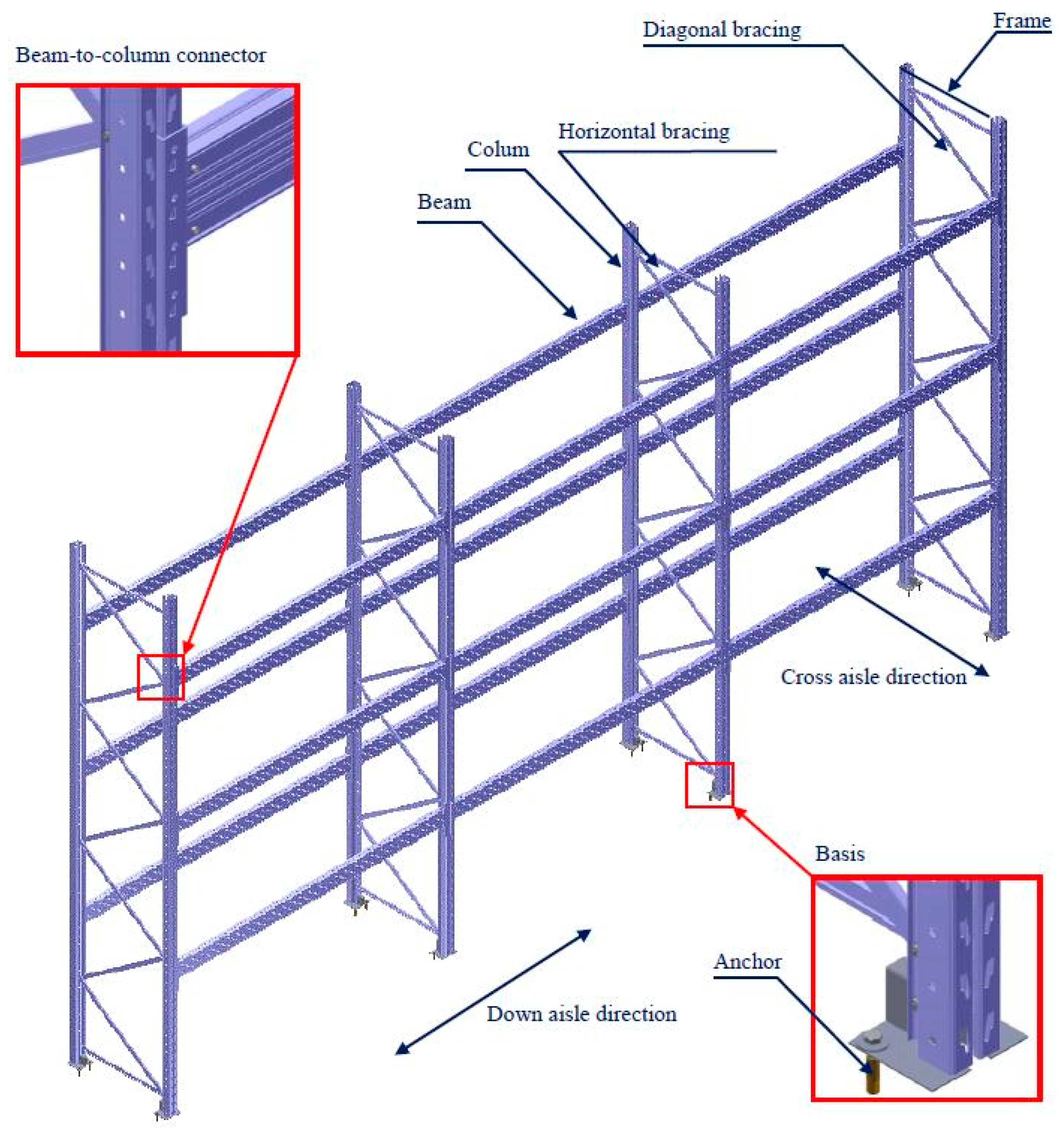
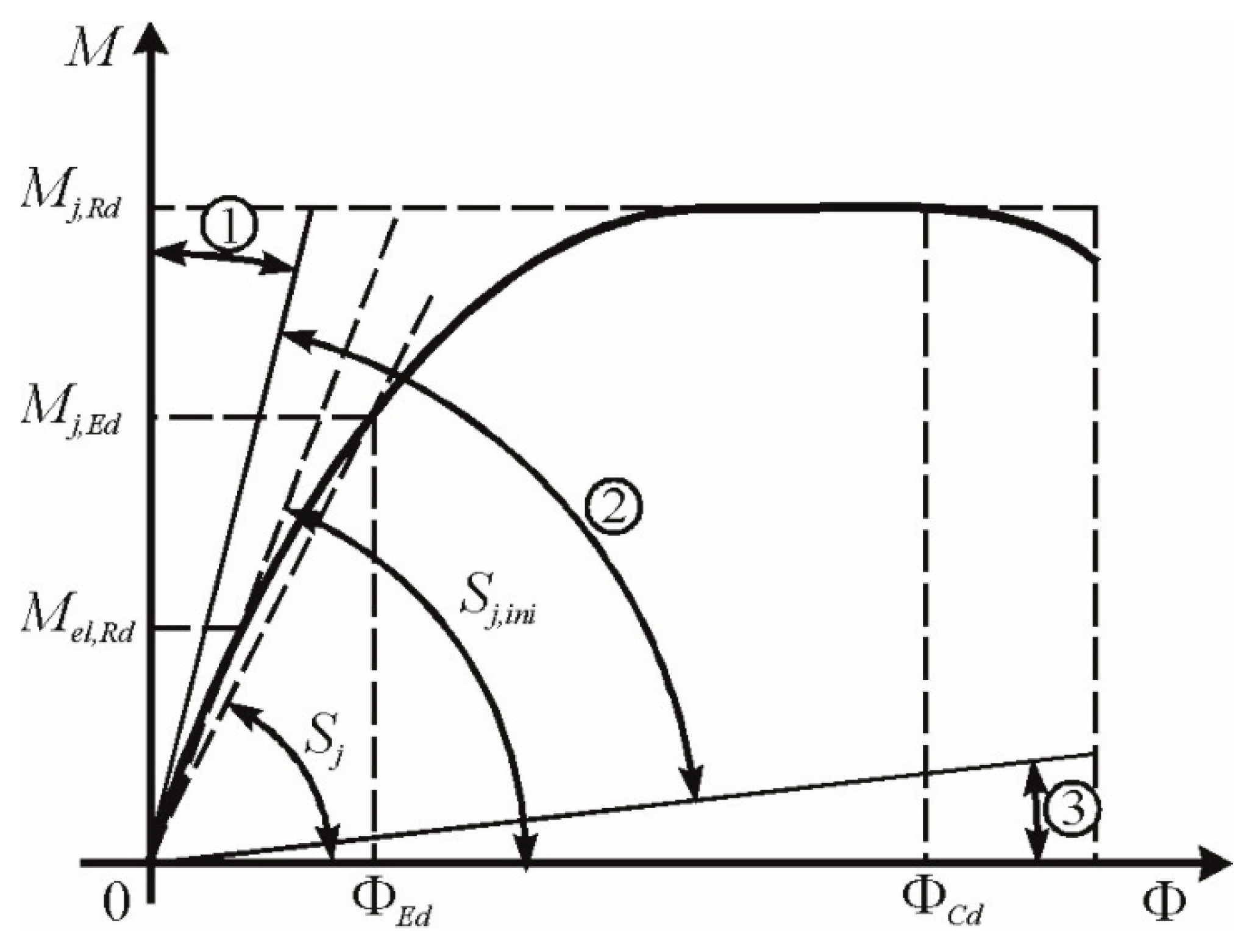
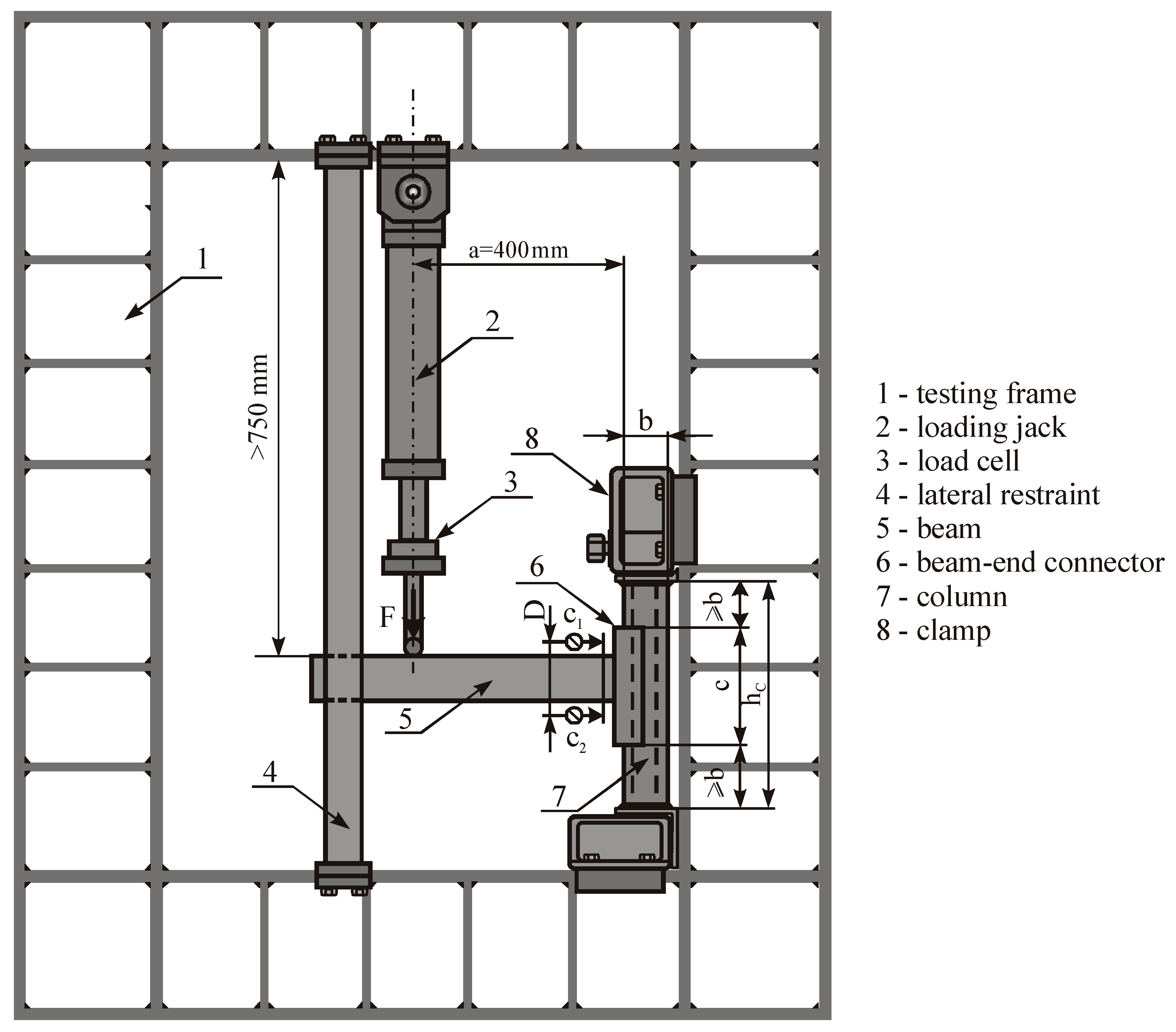
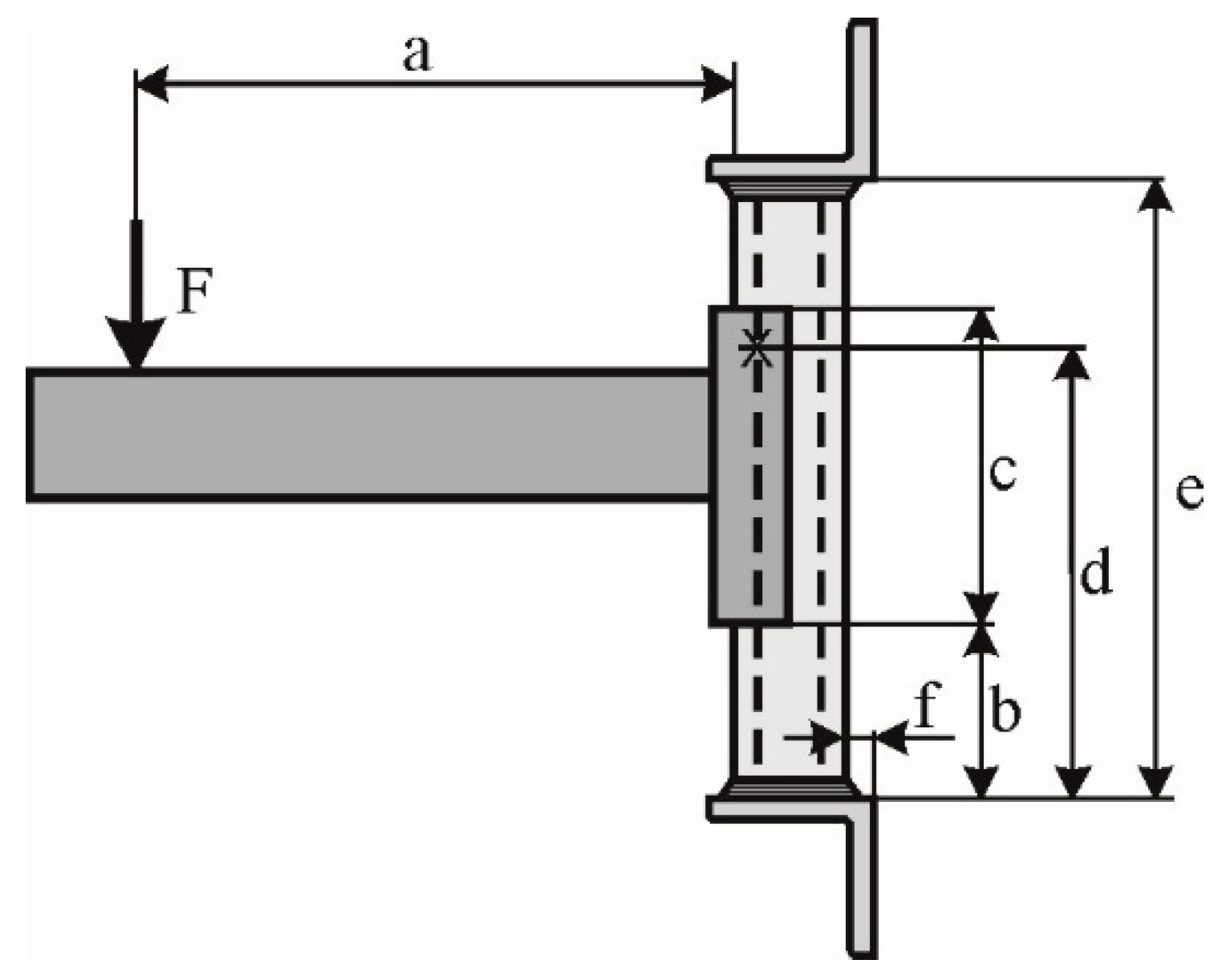
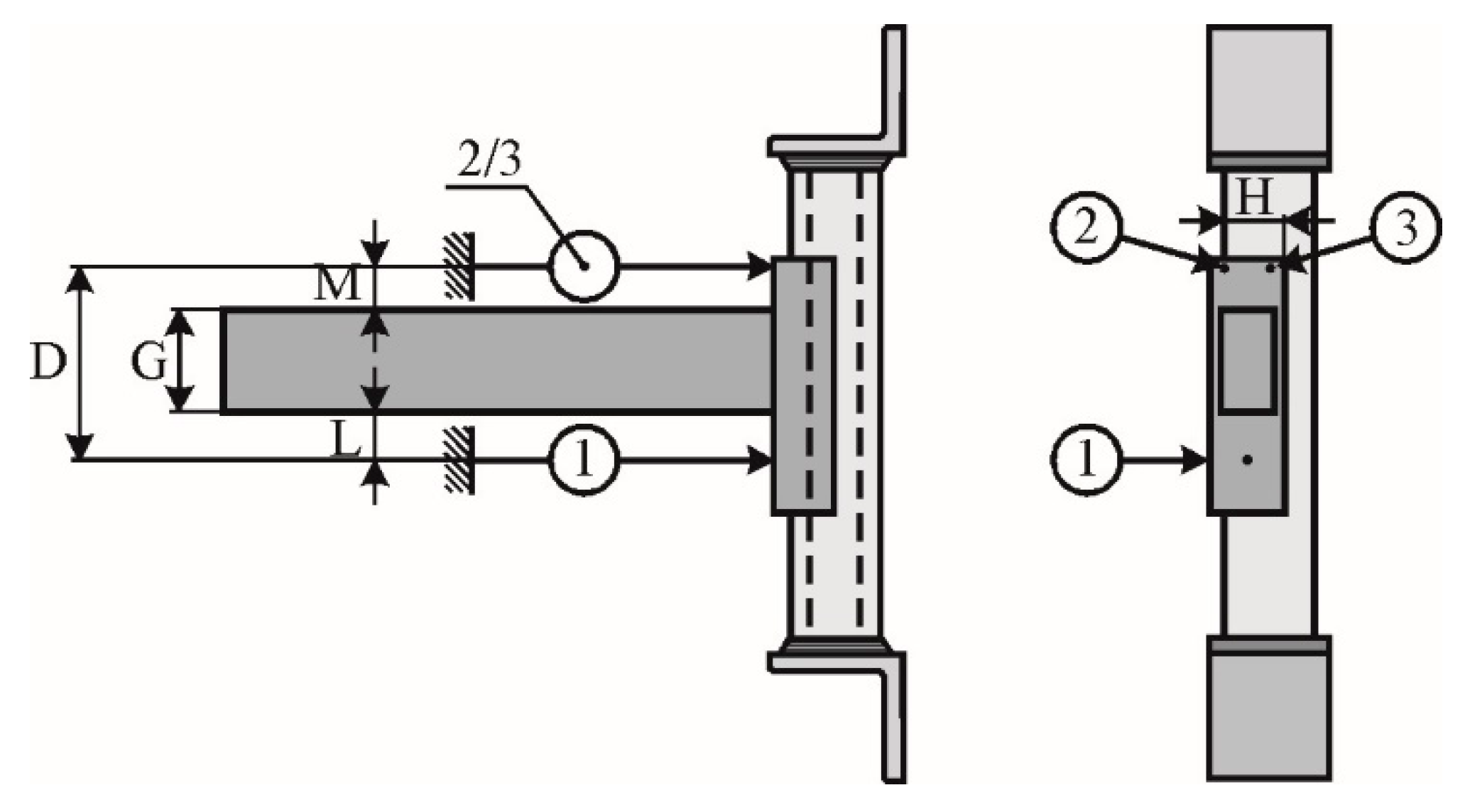

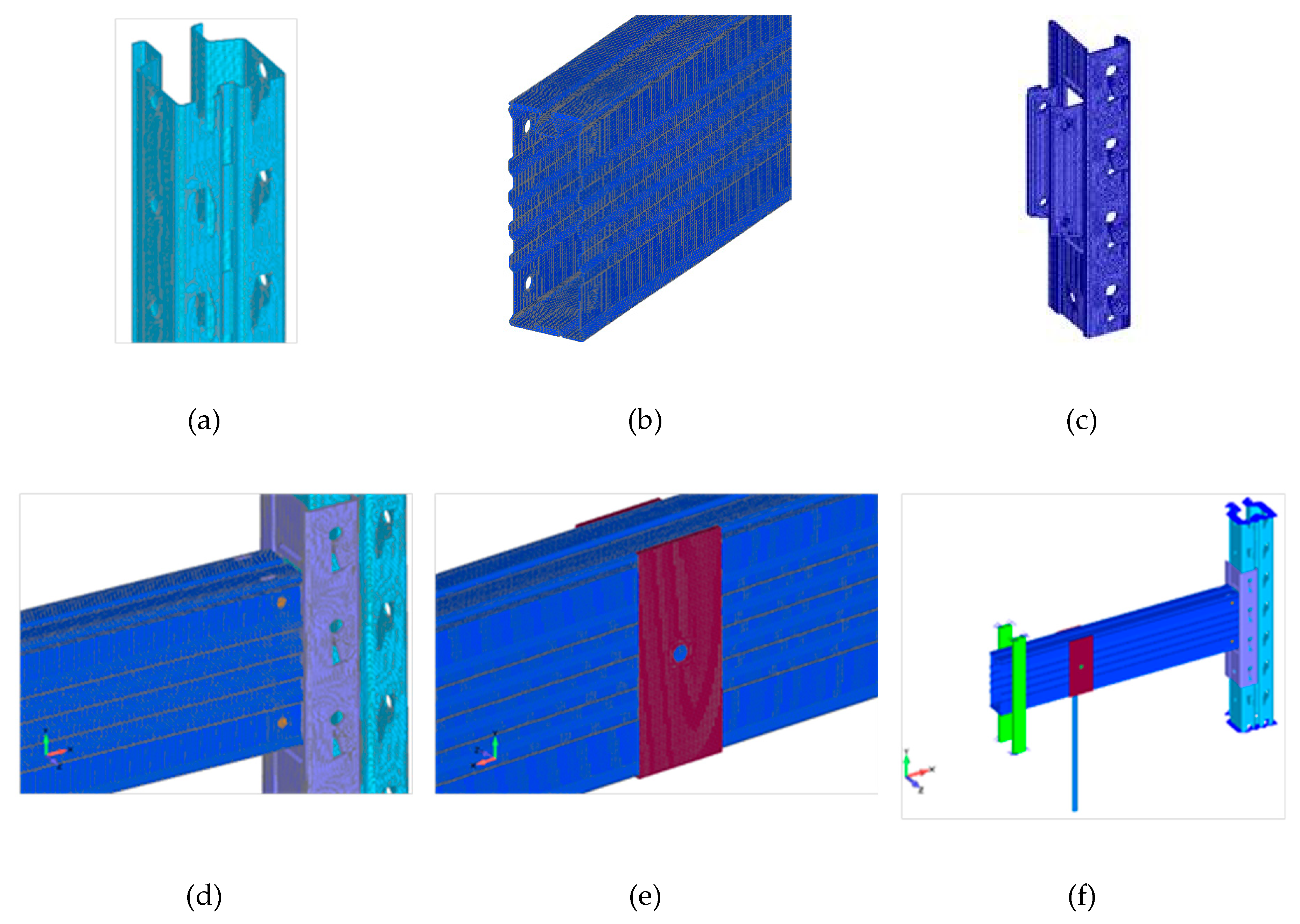

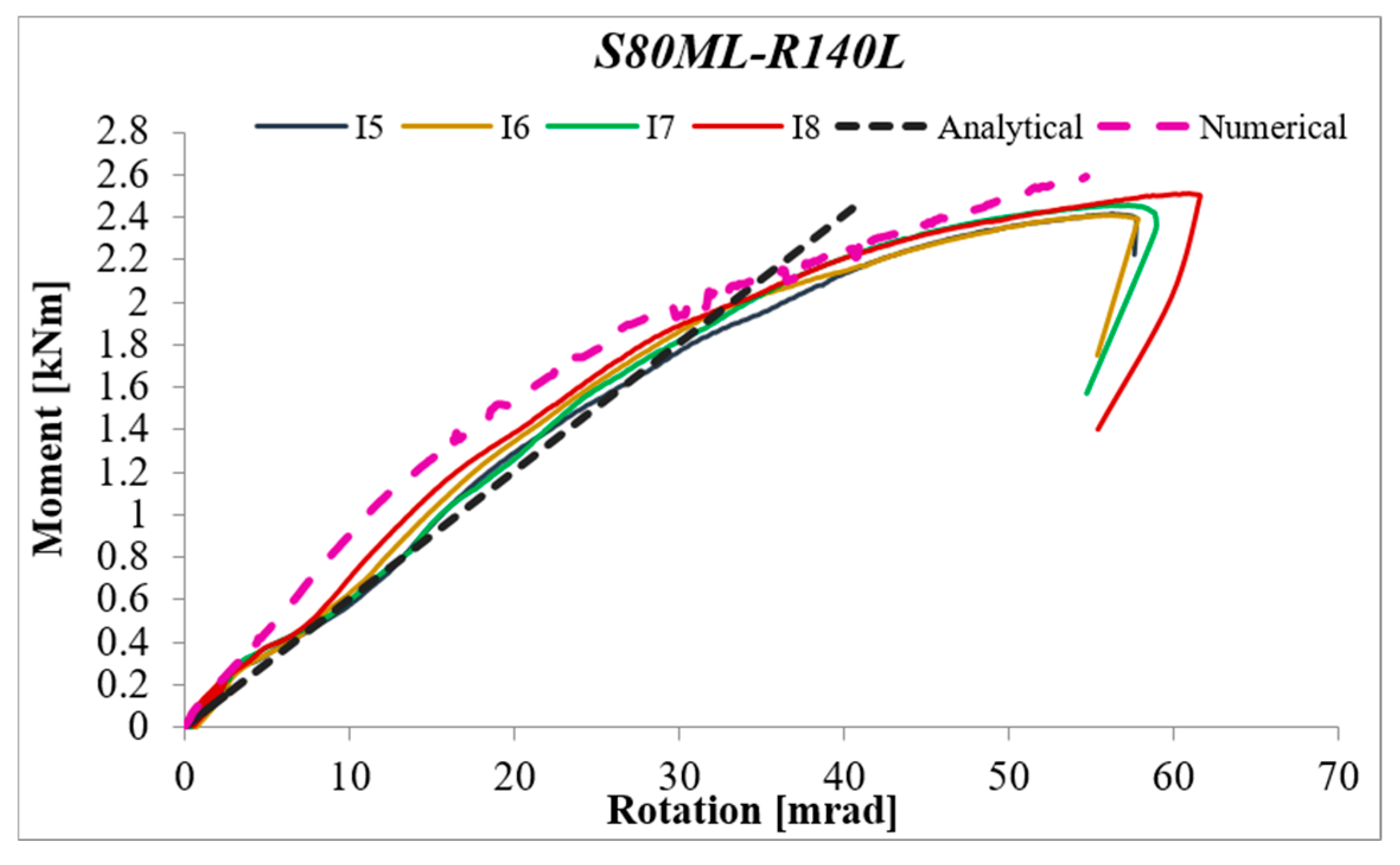
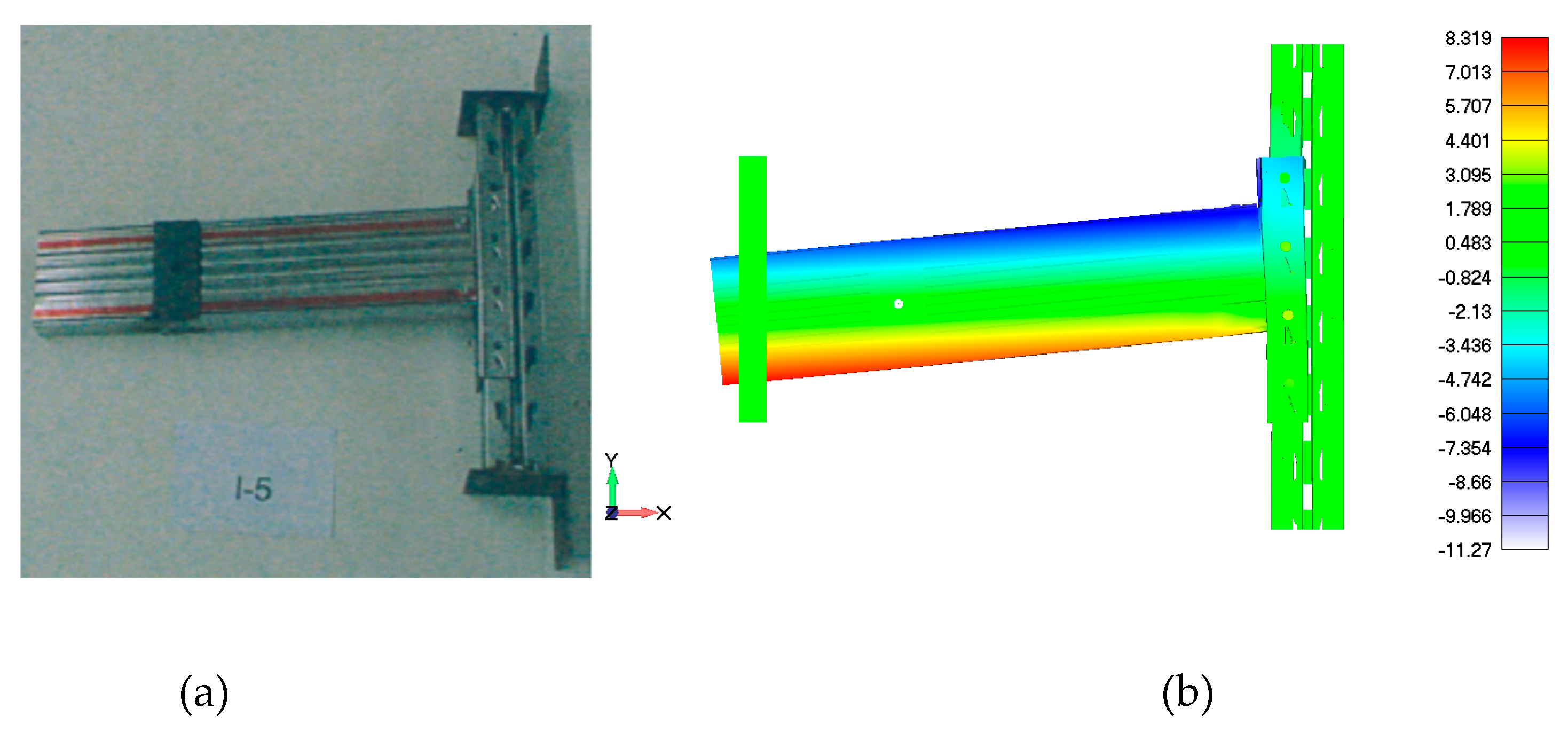
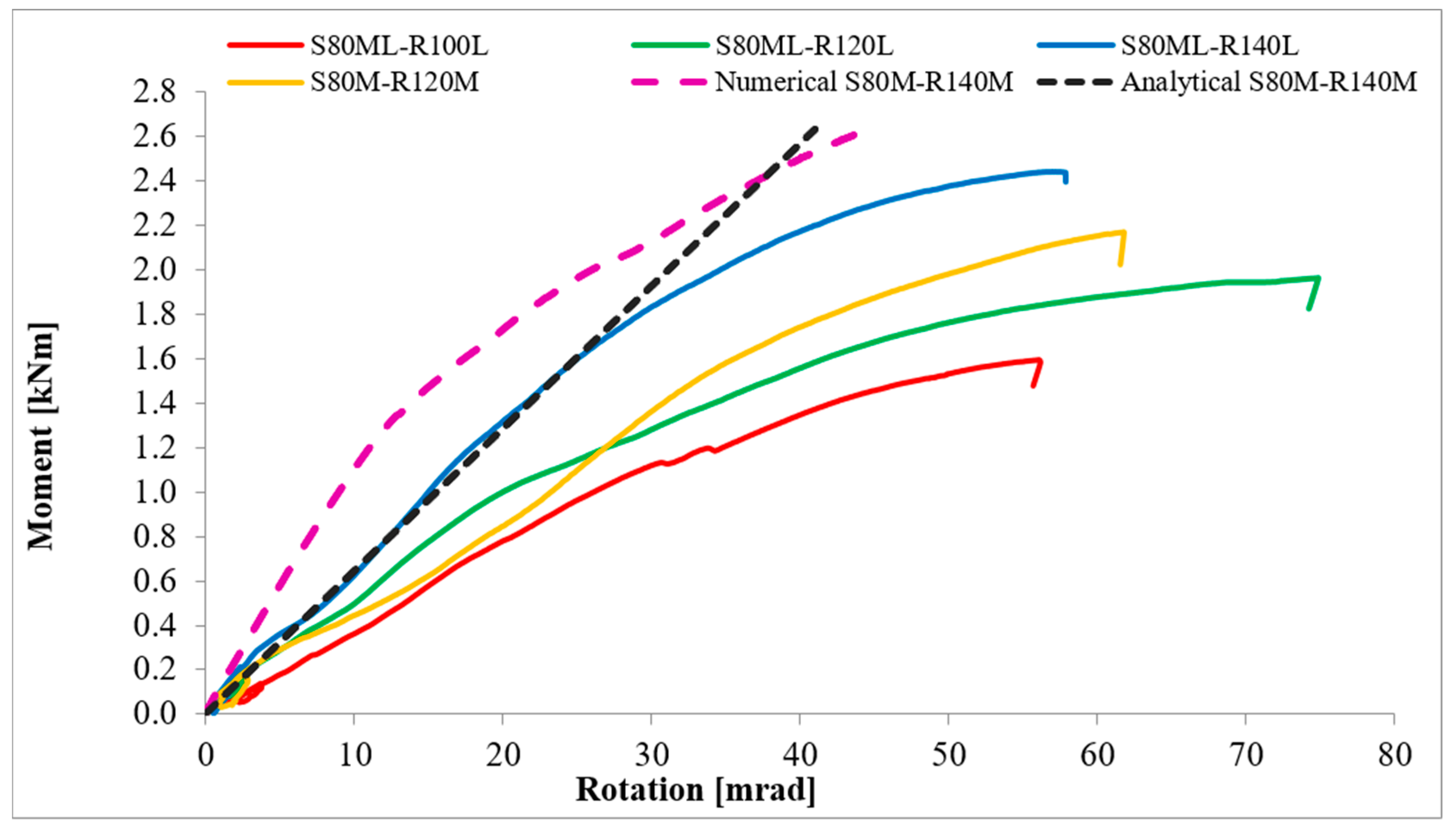
| No. | Joint (Column-Beam) | Column Wall Thickness, mm | Thickness of the Beam Wall, mm | Height of Beam Profile, mm | Experimental Sample |
|---|---|---|---|---|---|
| 1 | S80ML-R100L | 1.5 | 1 | 100 | G-5, G-6, G-7, G-8, (G-9) |
| 2 | S80ML-R120L | 1.5 | 1 | 120 | H-5, H-6, H-7, H-8, (H-9) |
| 3 | S80ML-R140ML | 1.5 | 1 | 140 | I-5, I-6, I-7, I-8, (I-9) |
| 4 | S80M-R120M | 2 | 1.25 | 120 | A-5, A-6, A-7, A-8, (A-10) |
| Joint | Sample | a, mm | b, mm | c, mm | d, mm | hc, mm | e, mm |
|---|---|---|---|---|---|---|---|
| S80ML-R100L | G-5 | 400 | 119 | 215 | 311 | 454 | 17.0 |
| G-6 | 400 | 120 | 215 | 312 | 454 | 19.1 | |
| G-7 | 400 | 118 | 214 | 311 | 454 | 19.9 | |
| G-8 | 400 | 118 | 214 | 311 | 454 | 19.3 | |
| G-9 | 400 | 119 | 215 | 140 | 454 | 18.5 | |
| S80M-R120M | A-5 | 400 | 120 | 214 | 311 | 455 | 23.2 |
| A-6 | 400 | 120 | 215 | 311 | 454 | 23.0 | |
| A-7 | 400 | 120 | 215 | 311 | 455 | 23.6 | |
| A-8 | 400 | 120 | 215 | 311 | 455 | 23.9 | |
| A-10 | 400 | 120 | 214 | 143 | 455 | 23.5 | |
| S80ML-R140L | I-5 | 400 | 120 | 290 | 389 | 530 | 19.7 |
| I-6 | 400 | 120 | 290 | 387 | 530 | 19.2 | |
| I-7 | 400 | 120 | 290 | 387 | 529 | 20.1 | |
| I-8 | 400 | 120 | 289 | 387 | 529 | 18.8 | |
| I-9 | 400 | 120 | 290 | 141 | 529 | 18.9 |
| Joint | Sample | G, Mm | H, mm | L, mm | M, mm |
|---|---|---|---|---|---|
| S80ML-R100L | G-5 | 99.5 | 69.2 | 47 | 12 |
| G-6 | 99.5 | 69.3 | 55 | 19 | |
| G-7 | 99.5 | 69.3 | 56 | 18 | |
| G-8 | 99.6 | 69.4 | 55 | 19 | |
| G-9 | 99.6 | 69.4 | 49 | 33 | |
| S80M-R120M | A-5 | 119.9 | 69.5 | 35 | 18 |
| A-6 | 119.9 | 69.7 | 35 | 18 | |
| A-7 | 119.9 | 69.3 | 27 | 19 | |
| A-8 | 119.6 | 69.4 | 27 | 18 | |
| A-10 | 119.9 | 69.5 | 30 | 30 | |
| S80ML-R140L | I-5 | 139.1 | 69.0 | 54 | 18 |
| I-6 | 139.5 | 69.2 | 54 | 17 | |
| I-7 | 139.0 | 69.2 | 55 | 16 | |
| I-8 | 139.0 | 69.1 | 54 | 17 | |
| I-9 | 139.3 | 69.3 | 46 | 35 |
| Joint | Sample | F0, kN | Fti, kN | t, s | Mti, kNm |
|---|---|---|---|---|---|
| S80ML-R100L | G-5 | 0.762 | 4.168 | 496 | 1.667 |
| G-6 | 0.393 | 4.087 | 577 | 1.635 | |
| G-7 | 0.402 | 4.093 | 575 | 1.637 | |
| G-8 | 0.394 | 4.084 | 495 | 1.634 | |
| G-9 | −0.179 | −2.486 | 512 | −0.994 | |
| S80M-R120M | A-5 | 0.581 | 5.678 | 340 | 2.271 |
| A-6 | 0.578 | 5.458 | 381 | 2.183 | |
| A-7 | 0.563 | 5.708 | 407 | 2.283 | |
| A-8 | 0.554 | 5.741 | 436 | 2.2.96 | |
| A-10 | −0.542 | −3.516 | 412 | −1.407 | |
| S80ML-R140L | I-5 | 0.516 | 6.042 | 375 | 2.417 |
| I-6 | 0.604 | 6.029 | 383 | 2.412 | |
| I-7 | 0.618 | 6.132 | 383 | 2.453 | |
| I-8 | 0.600 | 6.270 | 400 | 2.508 | |
| I-9 | −0.305 | −3.267 | 348 | −1.307 |
| Joint | Sample | Mti, kNm | Mm, kNm | Mk, kNm | MRd, kNm | Sti, kNm/rad | Sm, kNm/rad |
|---|---|---|---|---|---|---|---|
| S80ML-R100L | G-5 | 1.667 | 1.643 | 1.601 | 1.455 | 32.65 | 37.20 |
| G-6 | 1.635 | 41.07 | |||||
| G-7 | 1.637 | 35.28 | |||||
| G-8 | 1.634 | 39.79 | |||||
| S80M-R120M | A-5 | 2.271 | 2.258 | 2.121 | 1.928 | 46.22 | 44.15 |
| A-6 | 2.183 | 43.05 | |||||
| A-7 | 2.283 | 43.43 | |||||
| A-8 | 2.296 | 43.90 | |||||
| S80ML-R140L | I-5 | 2.417 | 2.448 | 2.329 | 2.117 | 60.26 | 63.42 |
| I-6 | 2.412 | 64.30 | |||||
| I-7 | 2.453 | 62.15 | |||||
| I-8 | 2.508 | 66.98 |
| Joint | Sample | C1 | C2 | C3 |
|---|---|---|---|---|
| S80ML-R100L | G-5 | 34.10479 | 0.0200 | 0.0002 |
| G-6 | 28.20721 | 0.0201 | 0.0003 | |
| G-7 | 30.61559 | 0.0701 | 0.0006 | |
| G-8 | 27.61125 | 0.0144 | 0.0002 | |
| S80M-R120M | A-5 | 44.65244 | 0.0159 | 0.0001 |
| A-6 | 46.20446 | 0.0875 | 0.0005 | |
| A-7 | 47.30988 | 0.0133 | 0.0008 | |
| A-8 | 47.27306 | 0.0125 | 0.0006 | |
| S80ML-R140L | I-5 | 41.19487 | 0.0225 | 0.0004 |
| I-6 | 38.47692 | 0.0326 | 0.0006 | |
| I-7 | 41.81794 | 0.0847 | 0.0007 | |
| I-8 | 36.31579 | 0.0223 | 0.0003 |
© 2020 by the authors. Licensee MDPI, Basel, Switzerland. This article is an open access article distributed under the terms and conditions of the Creative Commons Attribution (CC BY) license (http://creativecommons.org/licenses/by/4.0/).
Share and Cite
Vujanac, R.; Miloradović, N.; Vulović, S.; Pavlović, A. A Comprehensive Study into the Boltless Connections of Racking Systems. Metals 2020, 10, 276. https://doi.org/10.3390/met10020276
Vujanac R, Miloradović N, Vulović S, Pavlović A. A Comprehensive Study into the Boltless Connections of Racking Systems. Metals. 2020; 10(2):276. https://doi.org/10.3390/met10020276
Chicago/Turabian StyleVujanac, Rodoljub, Nenad Miloradović, Snežana Vulović, and Ana Pavlović. 2020. "A Comprehensive Study into the Boltless Connections of Racking Systems" Metals 10, no. 2: 276. https://doi.org/10.3390/met10020276
APA StyleVujanac, R., Miloradović, N., Vulović, S., & Pavlović, A. (2020). A Comprehensive Study into the Boltless Connections of Racking Systems. Metals, 10(2), 276. https://doi.org/10.3390/met10020276






